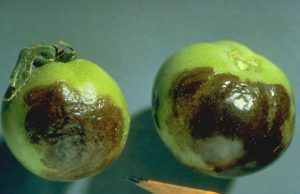
In 1845, potato farmers in Ireland began to notice spots on the leaves of their potatoes. They could not have known that those little spots, with spores transferred on the wind, would kill more than a million people by causing potato crop failure and famine across Ireland. The study of what caused the Irish potato famine and the mysterious leaf spot, was the beginning of the science of plant pathology. Isolated and now identified by modern science as P.Infestans, the pathogen we know today as blight.
Blight afflicts potatoes, peppers, eggplant, as well as tomatoes. To most experienced tomato growers, early and late blight seems an inevitable condition that comes around most every year.

Blight can be recognized by large spots or legions often in the middle of the leaves. The spots are often surrounded by a yellow border or light colored border. Blight can cause the loss of leaves resulting in sun scald, or can grow directly on the fruit of the plant.

Here is South Carolina, Clemson University has already reported a case of blight in April 2016 found in a home garden in Beaufort, SC. Blight, carried on the wind, is thought to have blown in from Florida.
Because blight can spread so easily on a breeze, it makes other plants nearby susceptible. Blight can easily be spread to your neighbor’s garden, or to a nearby commercial grower.
Prevent the spread of blight by taking the following precautions:
Prune the bottom of the plant to promote air circulation and to keep the plant from touching the ground.
- Steak tomatoes so that they stand up-right and have good air circulation.
- Warm moist conditions are perfect to promote the growth of blight. Never water at night. Water during morning hours so the plant can dry quickly.
- Learn to recognize blight on your plants and take measures to stop the spread. This can include spraying the plants, or in the worst case-destroying the plants. Infected plants should never be composted. They should be bagged and thrown in the trash or burned!
What do you do if you get blight?
- Prune infected leaves or branches and destroy. Do not leave trimmings in the garden or put into compost.
- Commercial growers have access to chemicals that will kill blight. Most home gardeners only have access to preventative measures. Copper sprays work well and some are approved for organic use.
- A baking soda solution of 1 tablespoon per gallon mixed with water and sprayed on the plant until dripping will change the PH of the plant’s surface to prevent the growth of blight.
Sources: (http://www.apsnet.org/edcenter/intropp/lessons/fungi/oomycetes/Pages/LateBlight.aspx),
(http://www.smithsonianmag.com/science-nature/scientists-finally-pinpoint-the-pathogen-that-caused-the-irish-potato-famine-71084770/?no-ist)
(http://newsstand.clemson.edu/mediarelations/highly-infectious-late-blight-disease-found-on-tomatoes-in-south-carolina/)
